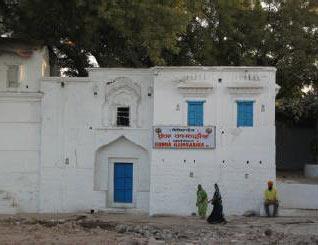Architecture
Hazur Sahib: Threatened Heritage
by Giani Partap Singh, Head Granthi, Sri Hazur SahibTranslated by Harinder Singh Mann
[Authors note: In my recent trip to Nanded, Maharashtra (India), I came to know that the hallmarks of Hazur Sahib's architectural tradition were being demolished in the name of modernization. There is also a tradition of giving guided tours of the Ramgharia Bunga which has been going back at least six generations that will also be history if something isn't done to preserve these buildings. The information I am about to present is because of my desire to help preserve our traditions by providing the history of the buildings so that enough public pressure can be applied to keep the aforementioned buildings intact.]
Historical Preamble
The Khalsa Raj was a time of prosperity and regal authority for the masses. Maharaja Ranjit Singh had established such a powerful force that adversaries were always looking to befriend him and the Khalsa Raj to avoid confrontation and maintain peace. In 1831, Lord Bentinck met Maharaja Ranjit Singh in the city of Ropar to inform him of the poor condition of the Takh Hazur Sahib as a gesture of goodwill and offering of friendship. The Maharaja was well known to be a patron in the preservation and regal development of important Sikh historical shrines.
The news from Bentinck greatly disturbed the Maharaja who said an ardas, and undertook to resurrect the Takht to its accorded stature.
Opportunity Unfolds
Hazur Sahib was under the jurisdiction of the Nizam of Hyderabad. He was a Muslim by faith and had to constantly contend with the Mahrattas, who were an empire of Hindus who felt they were entitled to govern over this region. A few skirmishes erupted between the Nizam's imperial army and the Mahrattas and the Nizam asked his chief minister, Chandhu Lal for advice to mitigate his losses. Chandu Lal advised the Nizam to seek the help of Maharaja Ranjit Singh and his forces.
Chandu Lal went north to meet Maharaja Ranjit Singh and explained the situation. Maharaja Ranjit Singh accepted the plea for help. At that time, it was traditional for kingdoms to offer a nazrana (token of thanks for support) of gold, silver, jewels, weapons and land. The Maharaja said he wanted to have the freedom to do construction work at Hazur sahib without any interruption from the authorities as his nazrana. The Nizam agreed.
Agreement
2000 soldiers, masons and architects were sent to Nanded with 100 freights of materials (ie; stone, marble, etc) to aide the Nizam and start the reconstruction of the Takht. Sardar Chanda Singh was sent to make sure that the military reinforcements were adequate and reconstruction work was completed with integrity. (Oral tradition states that the Nizam was willing to provide the materials for the construction, but Maharaja Ranjit Singh took on the responsibility and made arrangements for all the materials himself).
Construction of the Ramgharia Bunga
The soldiers and masons faced a crucial housing situation upon their arrival in Nanded. It was found that the sleeping arrangements in the tents were not adequate and the materials were in danger of being damaged by the elements. Sardar Chanda Singh made a decision to build a Bunga (mansion) for the masons and carpenters. This came to be known as the Ramgharia Bunga. (Khushal Singh - who now also carries the surname "Bunga" - the caretaker, showed me where the weapons were kept and the architectural provisions that were made in case of an attack). This building housed materials and the workers for the duration of their stay. It is dedicated to those who left their families to come and do work for the Guru.
Construction of Baradari
After the completion of the Ramgharia Bunga, it was decided by Sardar Chanda Singh, the granthi and the sangat that a temporary place was needed to continue the functioning of the Darbar and the Takht while the latter building was in the process of reconstruction. The Baradari (literally, the Twelve Doors) housed the sevadars (the Sikhs who had taken service in the Sikh court) and the Guru Granth Sahib. Nitnem (daily prayers) and katha (religious discourse) took place twice a day therein. One of the rooms in the Baradhari was used to house the instruments and weapons and preserved artifacts of Guru Gobind Singh. The Jathedar was Sher Singh at that time. He had given weapons to the Sikligars to house in the Guru's khazana (vault) during the construction of the Takht. They made a cart on which they transported all the weapons. The tradition of ceremonially displaying the weapons on that same cart still continues till today during religious processions.
TO BE CONTINUED .... "What You Can Do to Stop the Destruction".
For further info: www.punjabheritage.org
Conversation about this article
1: Gagan Deep Singh (Blore, India), April 23, 2007, 9:44 AM.
I have studied and lived in Huzoor Sahib for 4.5 years. I know the condition there. The road leading to Sachkhand Sahib is pretty narrow and during festivals it gets crowded to the extent of stampede. The lodges need immediate reconstruction as they are very old and do not have proper stay arrangments. The Jora Ghar is also very small and gets overloaded during festive season. Two (out of four) main extrances to Sachkhand Sahib are practically inaccessible to the main public, to the extent that many visitors do not even know of them. The place is historic and needs to cater to the growing sangat. In my view the reconstruction in and around gurudwara is not only desired, I think it is urgent and really the need of the hour. The Sikhs of Nanded Sahib are amongst the most loyal and honest people that one can ever find. It is because of them only that so many gurudwaras in the remote town of Nanded are still in good shape. I think along with Dr. Pasricha, whatever decision the people of Nanded have taken is best to protect Sachkhand Sahib. I am very sure that whatever they are doing, they are doing it right.
2: Sarjit Singh Khalsa (England), August 01, 2007, 3:18 PM.
These kind of things are happening because the country we gave our all to build and liberate behaves as if it is not ours as well ...
3: Harnam Singh (United Kingdom), July 06, 2008, 11:11 AM.
I feel sad that the heritage of Hazur Sahib is in jeopardy as this is the reason why many people go to the place in the first place. I am visiting Hazur Sahib in the near future and would be appalled to see it overrun by ignorance and bigotry. Many of us might want to live in Hazur sahib and this stupidity may prevent this from happening. But not to worry, we will do everything we can in preserving this landmark destination of the Sikhs around the globe.
4: Kiranjot Singh (Nanded, Hyderabad, India), March 21, 2009, 9:54 AM.
I am from Hazur Sahib (my native place). We would never allow Pasricha (a black spot on the name of Sikhs) to do such bad things. But he crossed the line ... and demolished those heritage sites at night!
5: Amrit (Nanded, Maharashtra, India), November 30, 2010, 5:51 AM.
Pasricha is an arrogant goon. He is openly threatening and using his police goons against people who try to voice their concerns about Sikh heritage and their rights. He is instrumental in the very dangerous politics being played against Sikhs in Nanded. The politics is aimed at destroying Sikh traditions and terrorizing Sikhs over there. Following are some of his evil deeds: 1) Gurudwara land worth of crores of rupees has been transferred to the Govt. as if Pasricha owned this land. When people protested, they were suppressed using police power. 2) Sikh houses were demolished giving them in turn meagre compensation and no ready residential alternatives. this was aimed at making gurudwara premises free of the Sikhs. 3) Historical buildings in the Sachkhand premises were demolished and a police centre has been set up in its place. 4) The position of the Gurdwara Main Gate has been changed so as to bring it in front of the last few Sikh homes near the Gurdwara and now he is all set to wipe out all these homes making the excuse that these are coming in the way of the Gurdwara main gate. Surprisingly, no Sikh organization has come to help so far.




